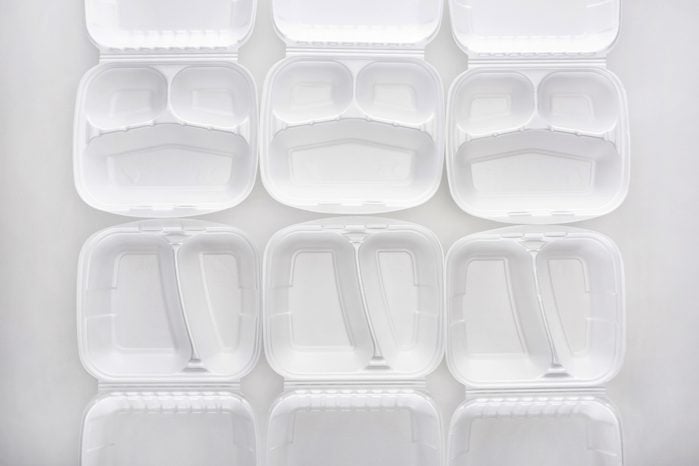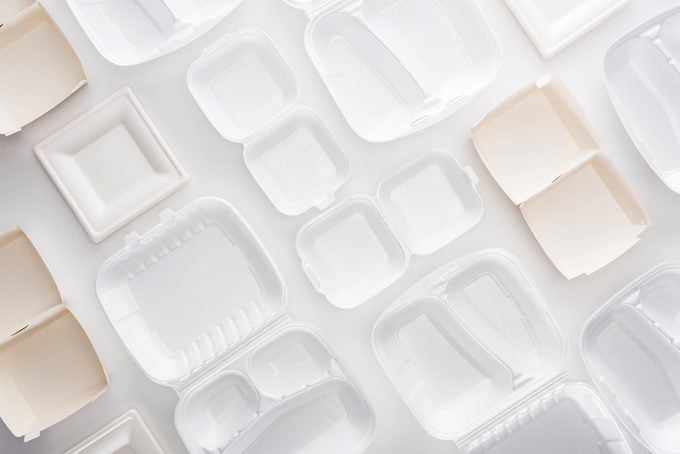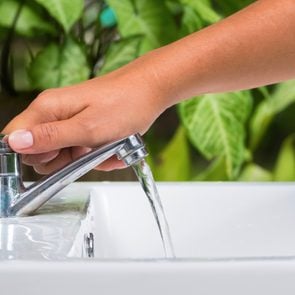Is Styrofoam Recyclable? Here’s What Experts Have to Say
Updated: Apr. 14, 2024

Learn more about Styrofoam recycling and what recycling or upcycling options you have
How many times have you grabbed a cup of coffee, picked up takeout in a Styrofoam container or used a Styrofoam plate at a picnic, only to toss it in the trash a few hours later? Those who care about sustainable living may want to invest in a reusable coffee cup, start patronizing a sustainable fast food restaurant or learn how to recycle the right way, because not only is Styrofoam not generally recyclable, but it’s also bad for the environment.
Just how big a problem is it? Consider that the United States produced 550,000 tons of Styrofoam containers, wraps and other packaging in 2018, of which less than 4% was recycled, according to the EPA. Read on to learn why some states, including Maine, Maryland, New York, Vermont and New Jersey, have banned Styrofoam food containers and coffee cups, and find out what you can do to help.
What is Styrofoam?
Styrofoam is a material made of polystyrene (EPS) foam, denoted by the recycling symbol #6. It’s commonly used as insulation, packaging, egg cartons, single-use plates, trays and more. Styrofoam with a capital “S” is a registered trademark for DuPont and is a specific type of polystyrene foam used by construction workers to construct and insulate homes.
Is Styrofoam recyclable? Can you recycle Styrofoam?
The short answer is no. You shouldn’t put Styrofoam into recycling bins.
The long answer is yes. Technically, some processors can recycle Styrofoam, but it rarely is.
Why is Styrofoam difficult to recycle?
There are a few reasons, starting with: Styrofoam is 95% air, which makes it big, bulky and hard to transport, because it takes up so much room.
It’s also expensive; by some estimates, it costs around $3,000 to recycle a ton of Styrofoam. (To put that in perspective, it costs under $100 to recycle a ton of paper.) “In order to recycle Styrofoam, recycling processors must invest in specialized machinery to process the material into condensed blocks,” says Leigh Ratterman, Climate Action Specialist for the city of Missoula, Montana. This equipment, along with the time it takes to process it, is often more costly than the market rate for recycled Styrofoam.
Lastly, because Styrofoam is porous, it’s nearly impossible to fully clean Styrofoam food containers, and contaminated containers can’t be recycled.
What should I do with Styrofoam?
First, check to see if your curbside recycling program accepts Styrofoam. If not, there may be a recycling center in your area that accepts Styrofoam. You can view an interactive map of foam recycling centers on the Foodservice Packaging Institute website. If you can recycle Styrofoam in your area, make sure to separate it from other materials, such as plastic and cardboard.
Or, to give Styrofoam new life, try upcycling. This can be as simple as reusing a Styrofoam cup as a container for seedlings, or offering it up for reuse on a local Buy Nothing Group on Facebook or Freecycle. Another option is to check with your local UPS store; some may accept Styrofoam packing peanuts for reuse.
The downsides of Styrofoam

The downsides to Styrofoam are many:
- It takes up to 500 years to biodegrade.
- Fifty potentially hazardous chemical byproducts are released during the manufacturing of Styrofoam.
- It’s made from Styrene, a probable carcinogen.
- When Styrofoam is burned, it releases harmful chemicals into the air.
- Because it’s lightweight, Styrofoam that is not disposed of properly may travel and wind up in waterways, where it may eventually be eaten by fish or other sea life and cause harm to those animals.
Alternatives to Styrofoam
Since Styrofoam isn’t recyclable on a large scale, try to reduce your consumption of it. You can do this by:
- Carrying a reusable coffee cup so you don’t have to use a Styrofoam one at the coffee shop.
- Patronize restaurants that use takeout containers made of paper, or bring your own container.
- Support sustainable brands that use biodegradable packaging.
- When shipping gifts of products, use non-toxic biodegradable packing peanuts and paper bubble wrap, as plastic bubble wrap isn’t easily recyclable either.
Conclusion
Though Styrofoam technically is recyclable, the vast majority of it winds up in landfills, or worse, polluting the seas. If you want to do more to help the environment, aim to limit your use of Styrofoam, learn how to recycle just about anything.
Source:
- Leigh Ratterman, Climate Action Specialist for the city of Missoula, Montana



